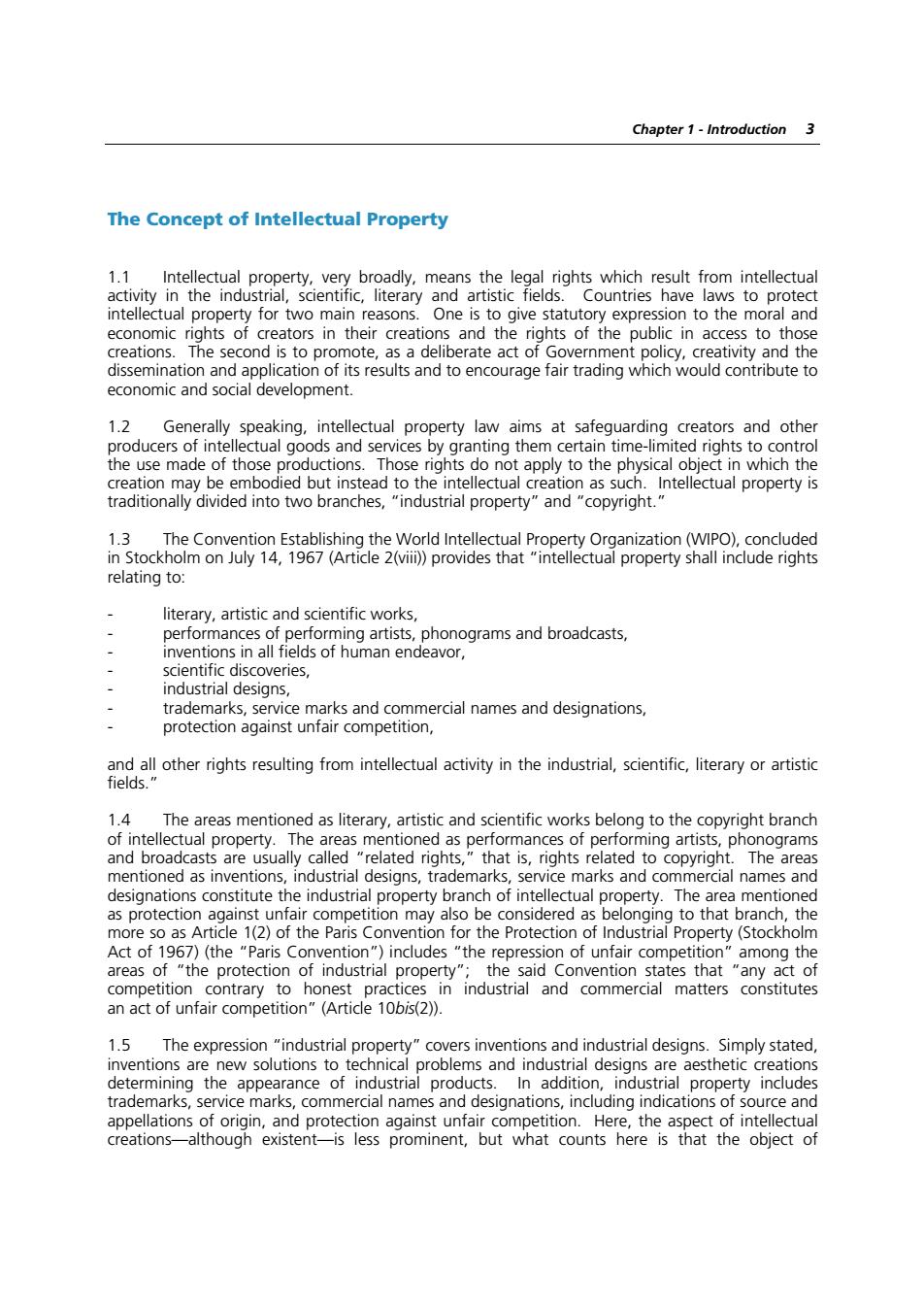
Chapter1-Introduction 3 The Concept of Intellectual Property resion to the moral and economic economic and social development. 12 Generally speaking intellectual r perty law aims at safequarding creators and othe producers of intellectual goods and services by granting them certain time-limited rights to contro the use made of those productions.Thoseights o ot apply to the traditionally divided into two branches,industrial property"and"copyright. relating to: literary.artistic and scientific works performances eoming artists,phonograms and broadcasts. of human endeavor, industrial designs, KS,S miematcanc8momerdlnamesanddesignatorns otherhrom inllintheindusira eraryor oftellmeo ar ando ben to t Peh9san ght industrial designs,trademarks e marks and com mercial names and d as to that bran h Act of Paris Convention"include "among the competition contrary to honest practices in industrial and commercial matters constitutes an act of unfair competition"(Article 10bis(2)). 1.5 The expression"industrial property"covers inventions and industrial designs.Simply stated new solutions to technica problems and industrial designs are aesthetic creation derermp Druone oroperD mn
Chapter 1 - Introduction 3 The Concept of Intellectual Property 1.1 Intellectual property, very broadly, means the legal rights which result from intellectual activity in the industrial, scientific, literary and artistic fields. Countries have laws to protect intellectual property for two main reasons. One is to give statutory expression to the moral and economic rights of creators in their creations and the rights of the public in access to those creations. The second is to promote, as a deliberate act of Government policy, creativity and the dissemination and application of its results and to encourage fair trading which would contribute to economic and social development. 1.2 Generally speaking, intellectual property law aims at safeguarding creators and other producers of intellectual goods and services by granting them certain time-limited rights to control the use made of those productions. Those rights do not apply to the physical object in which the creation may be embodied but instead to the intellectual creation as such. Intellectual property is traditionally divided into two branches, “industrial property” and “copyright.” 1.3 The Convention Establishing the World Intellectual Property Organization (WIPO), concluded in Stockholm on July 14, 1967 (Article 2(viii)) provides that “intellectual property shall include rights relating to: - literary, artistic and scientific works, - performances of performing artists, phonograms and broadcasts, - inventions in all fields of human endeavor, - scientific discoveries, - industrial designs, - trademarks, service marks and commercial names and designations, - protection against unfair competition, and all other rights resulting from intellectual activity in the industrial, scientific, literary or artistic fields.” 1.4 The areas mentioned as literary, artistic and scientific works belong to the copyright branch of intellectual property. The areas mentioned as performances of performing artists, phonograms and broadcasts are usually called “related rights,” that is, rights related to copyright. The areas mentioned as inventions, industrial designs, trademarks, service marks and commercial names and designations constitute the industrial property branch of intellectual property. The area mentioned as protection against unfair competition may also be considered as belonging to that branch, the more so as Article 1(2) of the Paris Convention for the Protection of Industrial Property (Stockholm Act of 1967) (the “Paris Convention”) includes “the repression of unfair competition” among the areas of “the protection of industrial property”; the said Convention states that “any act of competition contrary to honest practices in industrial and commercial matters constitutes an act of unfair competition” (Article 10bis(2)). 1.5 The expression “industrial property” covers inventions and industrial designs. Simply stated, inventions are new solutions to technical problems and industrial designs are aesthetic creations determining the appearance of industrial products. In addition, industrial property includes trademarks, service marks, commercial names and designations, including indications of source and appellations of origin, and protection against unfair competition. Here, the aspect of intellectual creations—although existent—is less prominent, but what counts here is that the object of
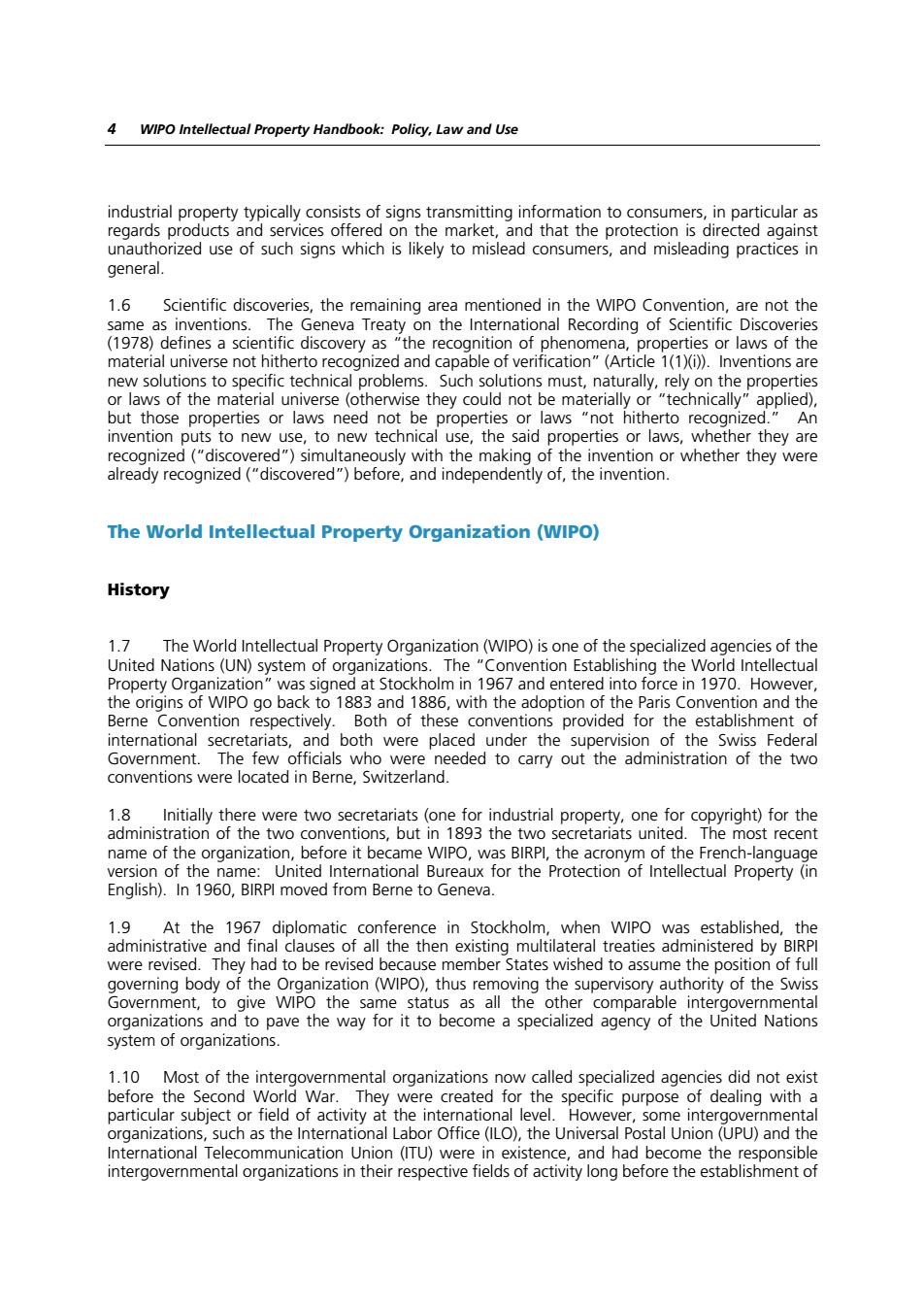
4 WIPO Intellectual Property Handbook:Policy,Law and Use industrial property typically consists of signs transmitting information to consumers,in particular as general. 16 Scientific disco tioned in the wpo con re not the e as inve ing of Scientific Disco 1978 )defines a sc fic discovery as y eof phenomena proper nate recognized ("discovered")simultaneously with the making of the invention or whether they were already recognized ("discovered")before,and independently of,the invention. The World Intellectual Property Organization(WIPO) History 17 The World Intellectual Property Organization(WIPO)is one of the specialized agencies of the United Nations(UN)system of or The "Convention Establish the perty to188 nd 188 and the se convention s provided for the establishment of nternationa conventions were located in Berne.Switzerland. 18 dustrial abt)for the name of the before it b oved otalthehenen5tocthol were revised. had to be revised b doverning body ny of ta organizations and to pave the way for it to become a specialized agency of the United Nations system of organizations. 1.10 Most of the intergovernmental organizations now called specialized agencies did not exist econd Wondo They w created for the specific purpose of dealing with Ewaeaoaaoanamacungn
4 WIPO Intellectual Property Handbook: Policy, Law and Use industrial property typically consists of signs transmitting information to consumers, in particular as regards products and services offered on the market, and that the protection is directed against unauthorized use of such signs which is likely to mislead consumers, and misleading practices in general. 1.6 Scientific discoveries, the remaining area mentioned in the WIPO Convention, are not the same as inventions. The Geneva Treaty on the International Recording of Scientific Discoveries (1978) defines a scientific discovery as “the recognition of phenomena, properties or laws of the material universe not hitherto recognized and capable of verification” (Article 1(1)(i)). Inventions are new solutions to specific technical problems. Such solutions must, naturally, rely on the properties or laws of the material universe (otherwise they could not be materially or “technically” applied), but those properties or laws need not be properties or laws “not hitherto recognized.” An invention puts to new use, to new technical use, the said properties or laws, whether they are recognized (“discovered”) simultaneously with the making of the invention or whether they were already recognized (“discovered”) before, and independently of, the invention. The World Intellectual Property Organization (WIPO) History 1.7 The World Intellectual Property Organization (WIPO) is one of the specialized agencies of the United Nations (UN) system of organizations. The “Convention Establishing the World Intellectual Property Organization” was signed at Stockholm in 1967 and entered into force in 1970. However, the origins of WIPO go back to 1883 and 1886, with the adoption of the Paris Convention and the Berne Convention respectively. Both of these conventions provided for the establishment of international secretariats, and both were placed under the supervision of the Swiss Federal Government. The few officials who were needed to carry out the administration of the two conventions were located in Berne, Switzerland. 1.8 Initially there were two secretariats (one for industrial property, one for copyright) for the administration of the two conventions, but in 1893 the two secretariats united. The most recent name of the organization, before it became WIPO, was BIRPI, the acronym of the French-language version of the name: United International Bureaux for the Protection of Intellectual Property (in English). In 1960, BIRPI moved from Berne to Geneva. 1.9 At the 1967 diplomatic conference in Stockholm, when WIPO was established, the administrative and final clauses of all the then existing multilateral treaties administered by BIRPI were revised. They had to be revised because member States wished to assume the position of full governing body of the Organization (WIPO), thus removing the supervisory authority of the Swiss Government, to give WIPO the same status as all the other comparable intergovernmental organizations and to pave the way for it to become a specialized agency of the United Nations system of organizations. 1.10 Most of the intergovernmental organizations now called specialized agencies did not exist before the Second World War. They were created for the specific purpose of dealing with a particular subject or field of activity at the international level. However, some intergovernmental organizations, such as the International Labor Office (ILO), the Universal Postal Union (UPU) and the International Telecommunication Union (ITU) were in existence, and had become the responsible intergovernmental organizations in their respective fields of activity long before the establishment of
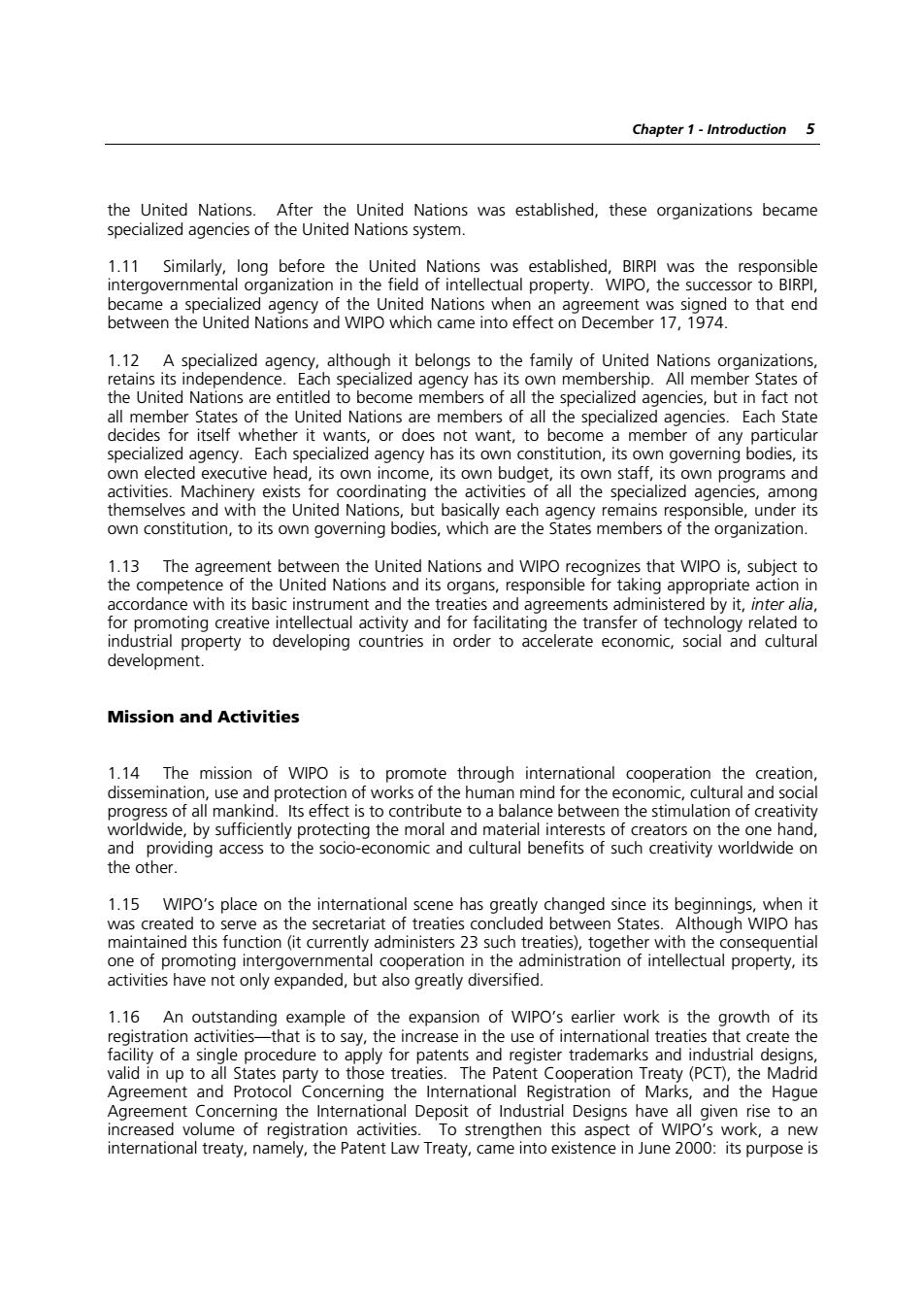
Chapter1-Introduction 5 1.11 Similarly.ng before the United Nations was established.was the of th United Nations when a operty i to that end between the United Nations and WIPO which came into effect on December 17,1974. to the family of United Nati retains its independenceac specialized agensy has its own membership.All member States of the Unit Nations areu ecome embers or all ne specialized agencies,but Tact no specialized agency has its own onstitution,its o n governing bodies,its activities.Machine xists he United Nation it The agree es that WIPO is,subject to vith its ha ans, 密西四6 ated to Mission and Activities mis ion of WIPO Its effec dn su the other. 115 the inte e its b rsified 1.16 s the growth of it the ply for patents and register traden anksandlndustnaldesig n up to nd Pro of Marks.and the Hagu e all given rise to an ne,hepaiarewTrd strenghe
Chapter 1 - Introduction 5 the United Nations. After the United Nations was established, these organizations became specialized agencies of the United Nations system. 1.11 Similarly, long before the United Nations was established, BIRPI was the responsible intergovernmental organization in the field of intellectual property. WIPO, the successor to BIRPI, became a specialized agency of the United Nations when an agreement was signed to that end between the United Nations and WIPO which came into effect on December 17, 1974. 1.12 A specialized agency, although it belongs to the family of United Nations organizations, retains its independence. Each specialized agency has its own membership. All member States of the United Nations are entitled to become members of all the specialized agencies, but in fact not all member States of the United Nations are members of all the specialized agencies. Each State decides for itself whether it wants, or does not want, to become a member of any particular specialized agency. Each specialized agency has its own constitution, its own governing bodies, its own elected executive head, its own income, its own budget, its own staff, its own programs and activities. Machinery exists for coordinating the activities of all the specialized agencies, among themselves and with the United Nations, but basically each agency remains responsible, under its own constitution, to its own governing bodies, which are the States members of the organization. 1.13 The agreement between the United Nations and WIPO recognizes that WIPO is, subject to the competence of the United Nations and its organs, responsible for taking appropriate action in accordance with its basic instrument and the treaties and agreements administered by it, inter alia, for promoting creative intellectual activity and for facilitating the transfer of technology related to industrial property to developing countries in order to accelerate economic, social and cultural development. Mission and Activities 1.14 The mission of WIPO is to promote through international cooperation the creation, dissemination, use and protection of works of the human mind for the economic, cultural and social progress of all mankind. Its effect is to contribute to a balance between the stimulation of creativity worldwide, by sufficiently protecting the moral and material interests of creators on the one hand, and providing access to the socio-economic and cultural benefits of such creativity worldwide on the other. 1.15 WIPO’s place on the international scene has greatly changed since its beginnings, when it was created to serve as the secretariat of treaties concluded between States. Although WIPO has maintained this function (it currently administers 23 such treaties), together with the consequential one of promoting intergovernmental cooperation in the administration of intellectual property, its activities have not only expanded, but also greatly diversified. 1.16 An outstanding example of the expansion of WIPO’s earlier work is the growth of its registration activities—that is to say, the increase in the use of international treaties that create the facility of a single procedure to apply for patents and register trademarks and industrial designs, valid in up to all States party to those treaties. The Patent Cooperation Treaty (PCT), the Madrid Agreement and Protocol Concerning the International Registration of Marks, and the Hague Agreement Concerning the International Deposit of Industrial Designs have all given rise to an increased volume of registration activities. To strengthen this aspect of WIPO’s work, a new international treaty, namely, the Patent Law Treaty, came into existence in June 2000: its purpose is
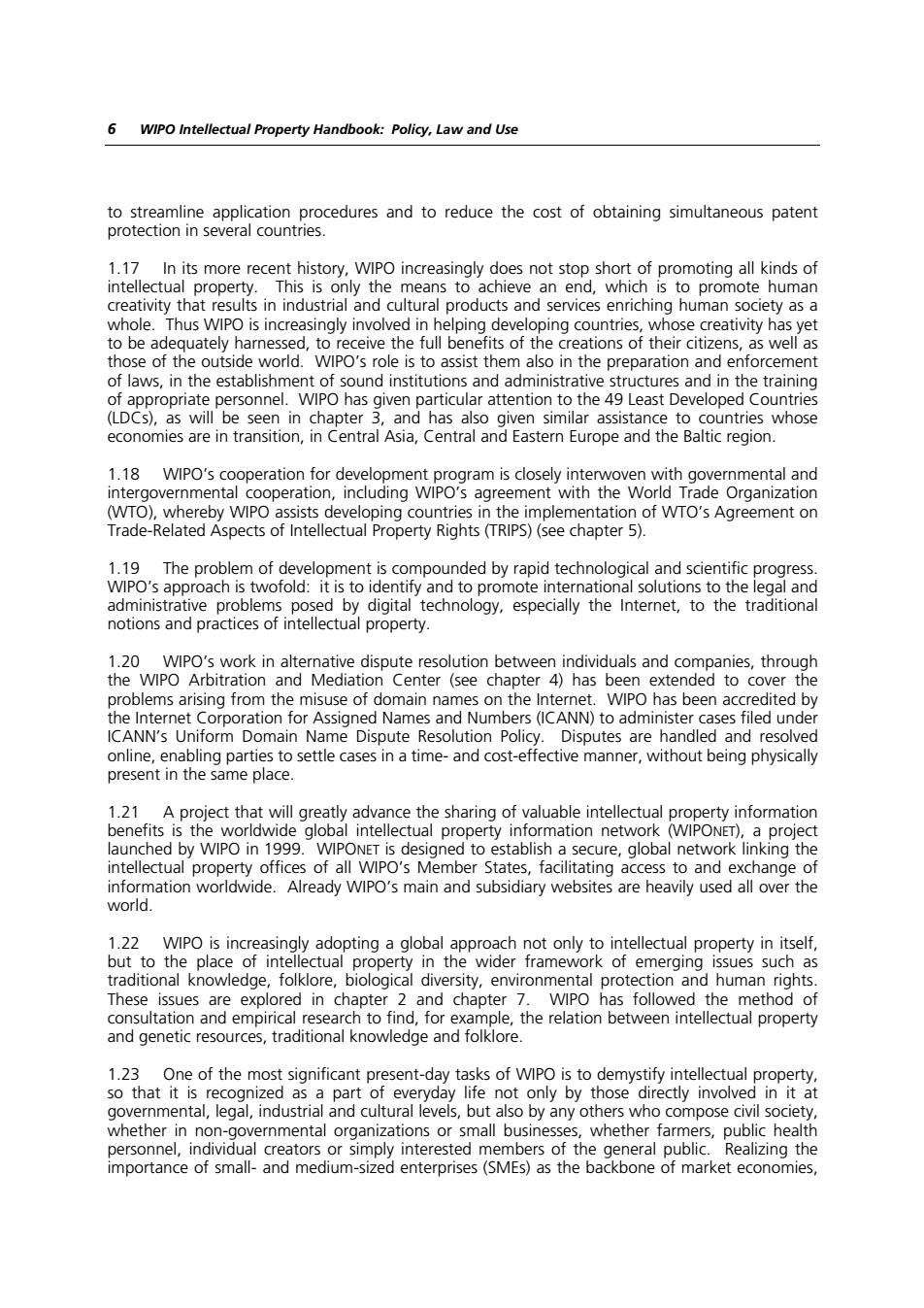
6 WIPO Intellectual Property Handbook:Policy,Law and Use to streamline application procedures and to reduce the cost of obtaining simultaneous patent protection in several countries. 1.17 In its more recent history.WIPO increasingly does not stop short of promoting all kinds of property. is only the means to nieve an en d,which promote humar Thus WIPO is increasingly involved in helping developing countries,whose creativity has o be ade quately arnes eive the full benefits of the creations of thei tize s,as well a nd in the trainin of appropriate personnel.WIPO has given particular attention to the 49 Least Developed Countries 1.18 WIPO's oceatoniorceeleemetPSeranredeemtenweveowhoierOmentalad WTO),whereb WIPo assists developin g countries in the implementation of WTO's Agreement on Trade-Related Aspects of Intellectual Property Rights(TRIPS)(see chapter 5). 110 The problem of development is compounded by rapid technological and scientific WIPO's approach i twofold:it is to iden tify and to promot solu erty. O N s NN)to adm onine,enabling parties to settle cases in a time and cost-effective manner.without being physical present in the same place. 1.21 a proiect that will greatly advance the sharing of valuable intellectual rty informatio benefits is the atefealprope ation worldwide.Already WPs man and subsidiary websites are heavly used all over the oadotin oonly tproperty to tin gengoeherebionbewennielecdualpropery 1.23 One of the most significant present-day tasks of WP is to demystify intellectual property whether s.public heal
6 WIPO Intellectual Property Handbook: Policy, Law and Use to streamline application procedures and to reduce the cost of obtaining simultaneous patent protection in several countries. 1.17 In its more recent history, WIPO increasingly does not stop short of promoting all kinds of intellectual property. This is only the means to achieve an end, which is to promote human creativity that results in industrial and cultural products and services enriching human society as a whole. Thus WIPO is increasingly involved in helping developing countries, whose creativity has yet to be adequately harnessed, to receive the full benefits of the creations of their citizens, as well as those of the outside world. WIPO’s role is to assist them also in the preparation and enforcement of laws, in the establishment of sound institutions and administrative structures and in the training of appropriate personnel. WIPO has given particular attention to the 49 Least Developed Countries (LDCs), as will be seen in chapter 3, and has also given similar assistance to countries whose economies are in transition, in Central Asia, Central and Eastern Europe and the Baltic region. 1.18 WIPO’s cooperation for development program is closely interwoven with governmental and intergovernmental cooperation, including WIPO’s agreement with the World Trade Organization (WTO), whereby WIPO assists developing countries in the implementation of WTO’s Agreement on Trade-Related Aspects of Intellectual Property Rights (TRIPS) (see chapter 5). 1.19 The problem of development is compounded by rapid technological and scientific progress. WIPO’s approach is twofold: it is to identify and to promote international solutions to the legal and administrative problems posed by digital technology, especially the Internet, to the traditional notions and practices of intellectual property. 1.20 WIPO’s work in alternative dispute resolution between individuals and companies, through the WIPO Arbitration and Mediation Center (see chapter 4) has been extended to cover the problems arising from the misuse of domain names on the Internet. WIPO has been accredited by the Internet Corporation for Assigned Names and Numbers (ICANN) to administer cases filed under ICANN’s Uniform Domain Name Dispute Resolution Policy. Disputes are handled and resolved online, enabling parties to settle cases in a time- and cost-effective manner, without being physically present in the same place. 1.21 A project that will greatly advance the sharing of valuable intellectual property information benefits is the worldwide global intellectual property information network (WIPONET), a project launched by WIPO in 1999. WIPONET is designed to establish a secure, global network linking the intellectual property offices of all WIPO’s Member States, facilitating access to and exchange of information worldwide. Already WIPO’s main and subsidiary websites are heavily used all over the world. 1.22 WIPO is increasingly adopting a global approach not only to intellectual property in itself, but to the place of intellectual property in the wider framework of emerging issues such as traditional knowledge, folklore, biological diversity, environmental protection and human rights. These issues are explored in chapter 2 and chapter 7. WIPO has followed the method of consultation and empirical research to find, for example, the relation between intellectual property and genetic resources, traditional knowledge and folklore. 1.23 One of the most significant present-day tasks of WIPO is to demystify intellectual property, so that it is recognized as a part of everyday life not only by those directly involved in it at governmental, legal, industrial and cultural levels, but also by any others who compose civil society, whether in non-governmental organizations or small businesses, whether farmers, public health personnel, individual creators or simply interested members of the general public. Realizing the importance of small- and medium-sized enterprises (SMEs) as the backbone of market economies
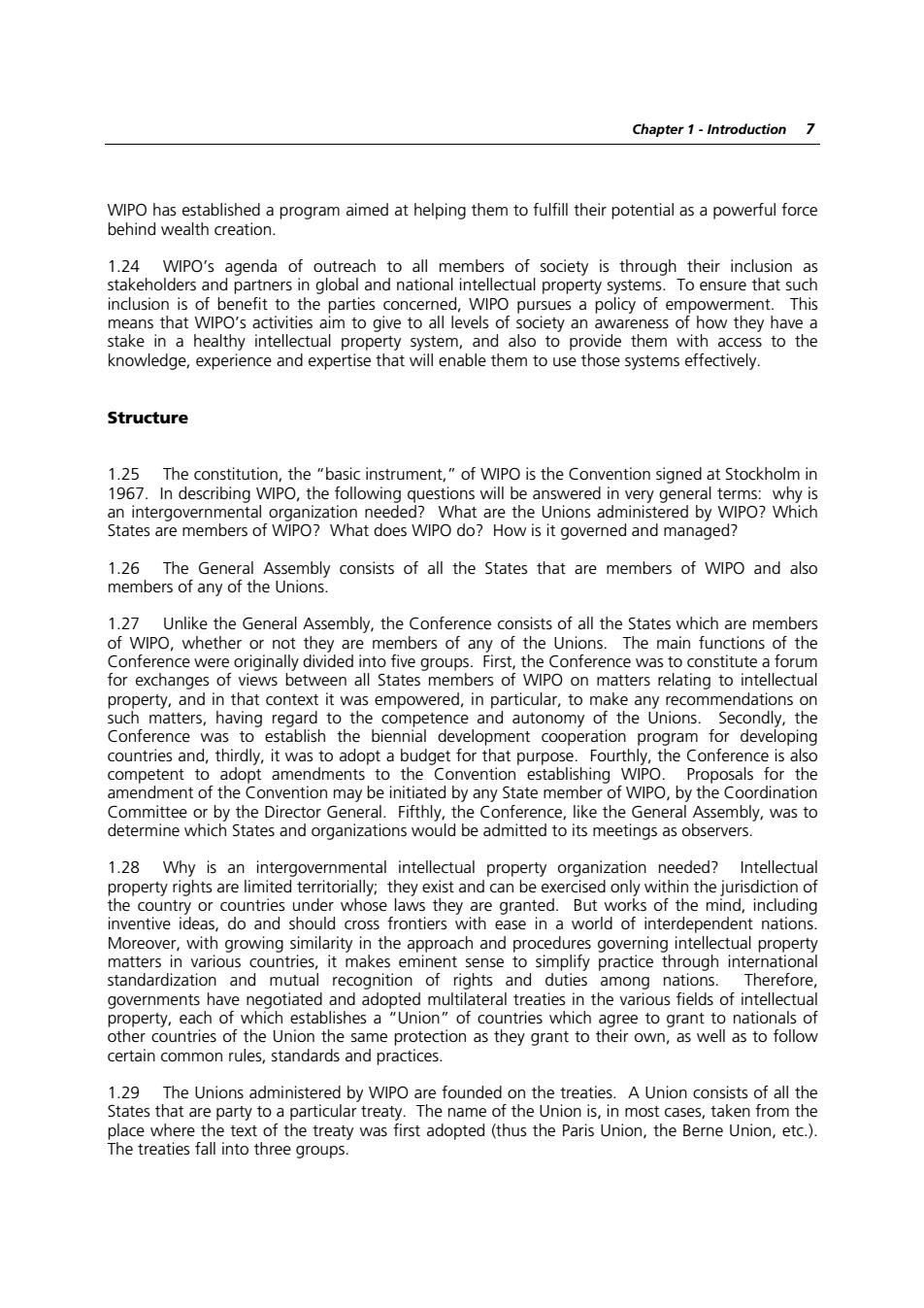
Chapter1-Introduction7 eOashoedapogan3medthebngthemoftmherpoenialsaponweiuioce eho2epoae9enteofnageiehndonailmemtbicanceyiheonanTahecscauf inclusion is of benefit to the pa ed,WIPO pur neinhateo5artitesanpongrmetoaevesot ociety an a Meage,pehenceanepeR8eehtienablehe thy use those systems e Structure 7.1 an interg overnmental o nization needed? States are members of WiPO?What does WIPO do? 1.26 The General Assembly consists of all the States that are members of WIPO and also members of any of the Unions. 1.27 Unlike the General Assembly,the Conference consists of all the States which are members of WIPO,whether or not th of any of the Unions. The main functions of the for een egeoenbdweeednitee9roepe5r,heOoOereneewaeogstoiedaeu ons nt c ram for de countries and,thirdly,it was to adopt a budget for that purpose Fourthly,the Conference is alsc ments ed by Committee or by the Director General.Fifthly,the Conference,like the General Assembly,was to determine which States and organizations would be admitted to its meetings as observers. 1.28 Why is an intergovernmental intellectual property organization needed? Intellectua oPcoorant st and can be exe sed only w in the ju ndent nation Moreover,with growing s tyin the approach and ed goveing inte al propert ts and duties natigh int governments have r adopted multilateral treaties in the various fields of intellectua s of the l the ction as th grant certain common rules,standards and practices 1 29 The Unior red by wIPO a ded the n consists of all the States that are party to a particular treaty treaty was first adopted (thus the Paris Union,the Berne Union,etc.). e grou
Chapter 1 - Introduction 7 WIPO has established a program aimed at helping them to fulfill their potential as a powerful force behind wealth creation. 1.24 WIPO’s agenda of outreach to all members of society is through their inclusion as stakeholders and partners in global and national intellectual property systems. To ensure that such inclusion is of benefit to the parties concerned, WIPO pursues a policy of empowerment. This means that WIPO’s activities aim to give to all levels of society an awareness of how they have a stake in a healthy intellectual property system, and also to provide them with access to the knowledge, experience and expertise that will enable them to use those systems effectively. Structure 1.25 The constitution, the “basic instrument,” of WIPO is the Convention signed at Stockholm in 1967. In describing WIPO, the following questions will be answered in very general terms: why is an intergovernmental organization needed? What are the Unions administered by WIPO? Which States are members of WIPO? What does WIPO do? How is it governed and managed? 1.26 The General Assembly consists of all the States that are members of WIPO and also members of any of the Unions. 1.27 Unlike the General Assembly, the Conference consists of all the States which are members of WIPO, whether or not they are members of any of the Unions. The main functions of the Conference were originally divided into five groups. First, the Conference was to constitute a forum for exchanges of views between all States members of WIPO on matters relating to intellectual property, and in that context it was empowered, in particular, to make any recommendations on such matters, having regard to the competence and autonomy of the Unions. Secondly, the Conference was to establish the biennial development cooperation program for developing countries and, thirdly, it was to adopt a budget for that purpose. Fourthly, the Conference is also competent to adopt amendments to the Convention establishing WIPO. Proposals for the amendment of the Convention may be initiated by any State member of WIPO, by the Coordination Committee or by the Director General. Fifthly, the Conference, like the General Assembly, was to determine which States and organizations would be admitted to its meetings as observers. 1.28 Why is an intergovernmental intellectual property organization needed? Intellectual property rights are limited territorially; they exist and can be exercised only within the jurisdiction of the country or countries under whose laws they are granted. But works of the mind, including inventive ideas, do and should cross frontiers with ease in a world of interdependent nations. Moreover, with growing similarity in the approach and procedures governing intellectual property matters in various countries, it makes eminent sense to simplify practice through international standardization and mutual recognition of rights and duties among nations. Therefore, governments have negotiated and adopted multilateral treaties in the various fields of intellectual property, each of which establishes a “Union” of countries which agree to grant to nationals of other countries of the Union the same protection as they grant to their own, as well as to follow certain common rules, standards and practices. 1.29 The Unions administered by WIPO are founded on the treaties. A Union consists of all the States that are party to a particular treaty. The name of the Union is, in most cases, taken from the place where the text of the treaty was first adopted (thus the Paris Union, the Berne Union, etc.). The treaties fall into three groups